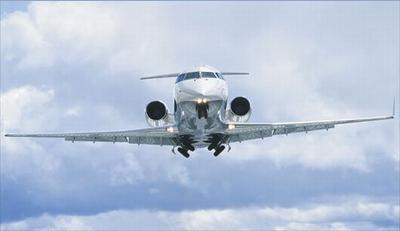Wed, Aug 29, 2007
Apparent Flap Defects To Blame
The Wall Street Journal reports the Federal Aviation
Administration and Canada's Transportation Safety Board have placed
tight operating restrictions on older Bombardier (nee Canadair)
CRJ-100, -200, and -440 aircraft. Those types are in operation with
several North American commuter airlines.

Citing the WSJ report, Reuters says regulators made their
decision following several reports of stuck flaps on the cited
aircraft. Those situations have led to several no-flap landings. No
fatal accidents related to the apparent defect have been
reported.
Both agencies have ordered affected airlines to make changes in
their maintenance, pilot training and dispatching practices,
according to media reports. The restrictions cover everything from
acceptable runway conditions and lengths for no-flap landings, to
carrying extra fuel in order to reach an alternate airport if
necessary, and altitude restrictions.
The FAA has also identified a minimum operating temperature at
cruise altitude of minus 76 degrees Fahrenheit, as extreme
cold may prevent the flaps from deploying, according to the
Journal.
The restrictions apply to roughly 684 aircraft in operation in
the US, and at least another 300 in operation throughout the world.
None of the affected models are still in production.
The reported flap failures appear to be similar to situations
encountered on two Atlantic Southeast Airlines CRJ-200s in March
2006. As ANN reported, two ASA
planes -- both flying as Delta Connection flights -- were involved
in three separate, emergency landing incidents at Wichita's
Mid-Continent Airport in the span of two days. All three
incidents were traced to defective flap deployment.

A spokesman for Bombardier's aerospace unit told the Journal
this week the manufacturer issued a voluntary safety bulletin in
March to operators of the affected aircraft. The company has been
working with regulators and airlines to develop a permanent
fix.
More News
Known Traffic With respect to ATC clearances, means aircraft whose altitude, position, and intentions are known to ATC.>[...]
Aero Linx: Aviation Suppliers Association (ASA) Established February 25, 1993, the Aviation Suppliers Association (ASA), based in Washington, D.C., is a not-for-profit association,>[...]
Abeam An aircraft is “abeam” a fix, point, or object when that fix, point, or object is approximately 90 degrees to the right or left of the aircraft track. Abeam indic>[...]
Aero Linx: The Air Charter Safety Alliance The group, called the Air Charter Safety Alliance, will raise awareness of illegal charter flights among potential customers, charter bro>[...]
“For months, ALPA has been sounding the alarm on the ongoing efforts by some aircraft manufacturers to remove pilots from the flight deck and replace them with automation. To>[...]
 ANN's Daily Aero-Term (06.10.24): Known Traffic
ANN's Daily Aero-Term (06.10.24): Known Traffic ANN's Daily Aero-Linx (06.10.24)
ANN's Daily Aero-Linx (06.10.24) ANN's Daily Aero-Term (06.11.24): Abeam
ANN's Daily Aero-Term (06.11.24): Abeam ANN's Daily Aero-Linx (06.11.24)
ANN's Daily Aero-Linx (06.11.24) Aero-News: Quote of the Day (06.11.24)
Aero-News: Quote of the Day (06.11.24)




